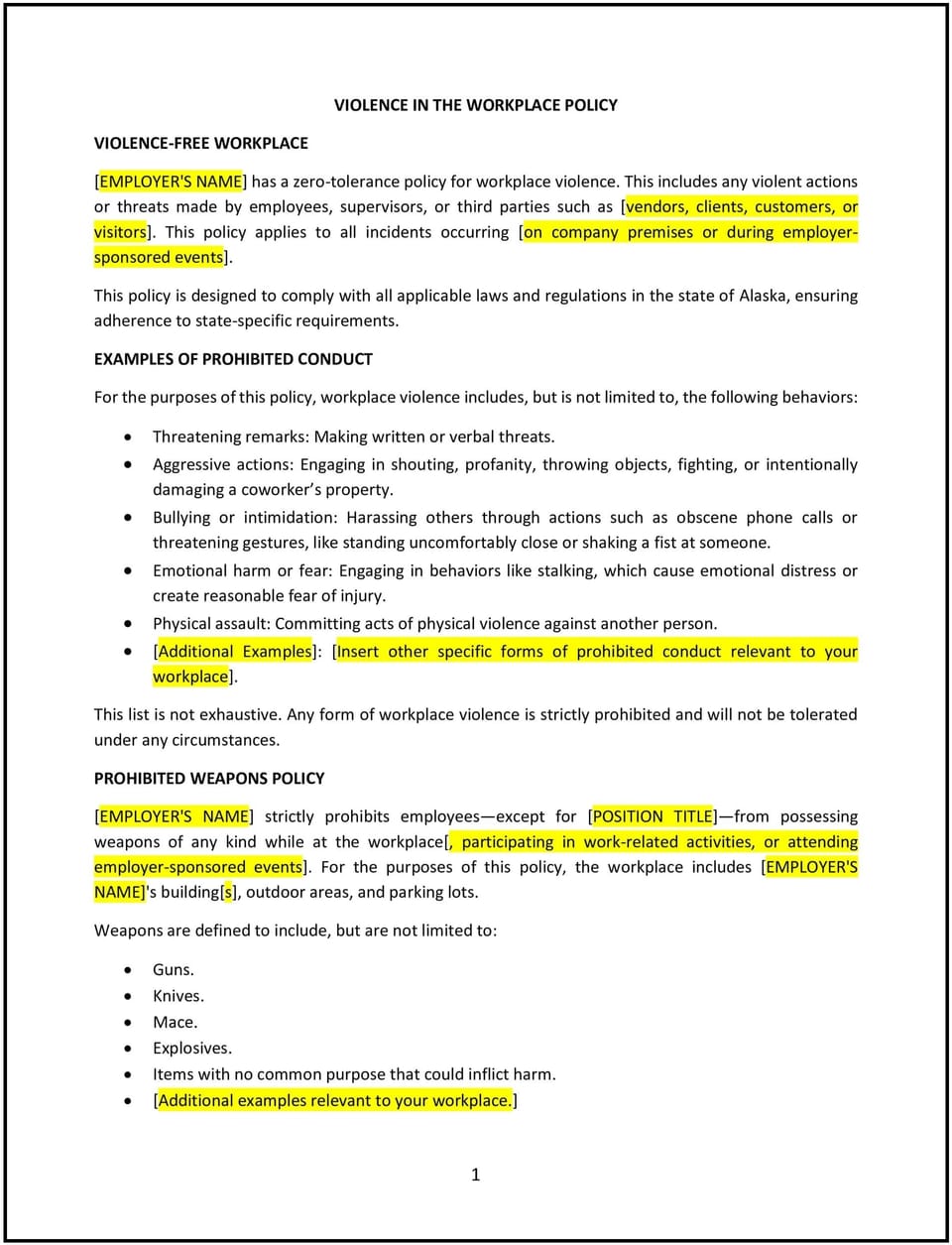Violence in the workplace policy (Alaska): Free template

Violence in the workplace policy (Alaska)
In Alaska, a violence in the workplace policy outlines guidelines for maintaining a safe and secure work environment by addressing threats, harassment, and physical or verbal aggression. This policy ensures that employees and management understand their roles in preventing, reporting, and responding to workplace violence. By implementing this policy, businesses can foster a culture of safety and respect while mitigating risks.
How to use this violence in the workplace policy (Alaska)
- Define prohibited behaviors: Clearly specify what constitutes workplace violence, including threats, intimidation, physical aggression, and harassment.
- Establish reporting procedures: Provide a step-by-step process for employees to report incidents, including how to maintain confidentiality and ensure non-retaliation.
- Include response protocols: Outline the company’s approach to addressing incidents, such as investigating reports, involving law enforcement if necessary, and offering support to affected employees.
- Address preventive measures: Include training programs, risk assessments, and clear communication of the policy to prevent workplace violence.
- Clarify disciplinary actions: Specify the consequences for engaging in workplace violence, such as suspension, termination, or legal action.
Benefits of using a violence in the workplace policy (Alaska)
A violence in the workplace policy provides several advantages for businesses in Alaska. Here’s how it helps:
- Ensures safety: Reduces the risk of violence and fosters a secure environment for employees and customers.
- Promotes reporting: Encourages employees to report incidents without fear of retaliation, ensuring prompt action.
- Supports compliance: Helps businesses adhere to state and federal safety regulations, reducing legal risks.
- Enhances awareness: Educates employees and managers on recognizing and addressing potential threats.
- Protects reputation: Demonstrates the company’s commitment to maintaining a respectful and professional workplace.
Tips for using a violence in the workplace policy (Alaska)
- Tailor to specific risks: Address unique risks relevant to your industry or location in Alaska, such as remote worksites or customer-facing roles.
- Conduct regular training: Provide employees and managers with training on recognizing warning signs and de-escalating potential conflicts.
- Perform risk assessments: Regularly evaluate workplace conditions to identify and mitigate potential hazards or vulnerabilities.
- Foster open communication: Create an environment where employees feel comfortable discussing safety concerns or reporting incidents.
- Update regularly: Revise the policy as needed to reflect changes in laws, workplace conditions, or industry practices.
Q: How can I identify behaviors considered workplace violence?
A: Behaviors include physical aggression, threats, verbal abuse, intimidation, harassment, or any actions that create a hostile or unsafe work environment.
Q: What steps should I take if an employee reports workplace violence?
A: Follow the reporting procedures in the policy, investigate promptly, document the incident, and involve law enforcement if necessary.
Q: How can I prevent workplace violence?
A: Conduct regular risk assessments, provide employee training on de-escalation techniques, and establish clear communication channels for reporting concerns.
Q: What actions should be taken after an incident of workplace violence?
A: Ensure the safety of all employees, address the immediate situation, investigate thoroughly, and apply appropriate disciplinary or legal measures.
Q: How often should this policy be reviewed?
A: The policy should be reviewed annually or when changes occur in workplace dynamics, legal requirements, or risk factors.
This article contains general legal information and does not contain legal advice. Cobrief is not a law firm or a substitute for an attorney or law firm. The law is complex and changes often. For legal advice, please ask a lawyer.


